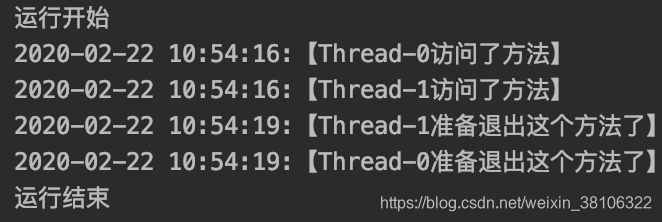示例代码
public class TestMain implements Runnable {
//格式化
SimpleDateFormat sim = new SimpleDateFormat("yyyy-MM-dd HH:mm:ss");
@Override
public synchronized void run() {
Date satrtTime = new Date();
String time = sim.format(satrtTime);
System.out.println(time + ":【" + Thread.currentThread().getName() + "访问了方法】");
try {
//睡眠3秒
Thread.sleep(3000);
} catch (InterruptedException e) {
e.printStackTrace();
}
Date endTime = new Date();
String time2 = sim.format(endTime);
System.out.println(time2 + ":【" + Thread.currentThread().getName() + "准备退出这个方法了】");
}
public static void main(String[] args) throws Exception {
//创建一个对象testMain1
TestMain testMain1 = new TestMain();
//再创建一个对象testMain2
TestMain testMain2 = new TestMain();
System.out.println("运行开始");
Thread thread1 = new Thread(testMain1);
Thread thread2 = new Thread(testMain2);
thread1.start();
thread2.start();
//让主线程做个等待,等线程一和线程二都执行完它才继续执行
thread1.join();
thread2.join();
System.out.println("运行结束");
}
}
运行结果如下:

总结
从运行结果可以看出,Thread-0和Thread-1这两个线程几乎是同时进入,以及同时退出的,这是因为是对象锁,当对象不同了,锁也就是不同的,所以大家竞争的不是同一把锁,自然可以一起运行,无需等待。
